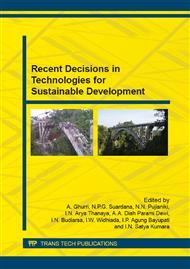p.3
p.9
p.17
p.24
p.30
p.36
p.41
p.47
Asphalt Pavement Temperature Profile for Tropical Climate in Indonesia
Abstract:
Environmental and climatic factors directly affect the temperature of asphalt pavement layers. Air temperature is one of the most important environmental factors that significantly affect the temperature distribution profile of asphalt pavement layers. It is important therefore, to comprehend the asphalt strength characteristics because of the differences in asphalt pavement designs. This study was conducted in tropical area with high humidity in Indonesia. A testing method was carried out to measure both temperature and humidity using thermocouples equipped with data logger and an application program of SAGA Technology. Measurements were taken for consecutive seven sunny days in July 2014. The average values obtained for hourly air temperature and humidity were ranging from 24.92 to 36.98 °C and from 50.31 to 83.69% respectively. Meanwhile, pavement surface temperatures measured at 0, 20 and 65 millimeters depths were varied from 25.29 to 45.65 °C, from 25.37 to 43.59 °C, and from 26.70 to 38.54 °C respectively. Both air and asphalt pavement temperatures are sharply increased from 10:00 a.m. to 02:00 p.m. and are gradually decreased afterward.
Info:
Periodical:
Pages:
17-23
Citation:
Online since:
July 2015
Authors:
Keywords:
Price:
Сopyright:
© 2015 Trans Tech Publications Ltd. All Rights Reserved
Share:
Citation:


